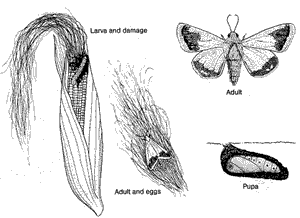 |
The corn earworm, the larvae of a brown moth, is a white to greenish red worm with four prolegs. It is 1 1/2 inches long and spined. The first earworm generation of the season chews the buds and leaves of corn and certain other crops; later generations feed on the developing corn silks and kernels at the tip of the ears just inside the husk. Corn earworms exist throughout the U.S., but they are most prevalent in the south and central states. Their pupae overwinter in the soil, emerging in late spring.
Symptoms of Corn Earworm
On Corn
Corn earworm damages buds and young corn plants. Plants may be stunted. Maturing corn ears are destroyed starting at their tips. Telltale damp worm castings can be seen in the silk of affected ears.
On Other Plants
Corn earworms eat holes in the leaves of certain ornamental plants and some other vegetables including Lima beans, snapbeans, okra, summer squash, winter squash, tomatoes, and some ornamental plants.
Discovering Corn Earworms
Pheromone Traps - You can monitor and trap the moth that lays the eggs producing the corn earworm with a pheromone bait, however this is a commercial product and will cost over $40. This warning allows you to take other control steps immediately. If you use enough traps you may actually control the pest with these devices. Three traps are adequate for general control for up to 5,000 square feet of corn.
Trap Crops - Use smartweed, which attracts corn earworm, as a trap crop. Locate plants within 10 to 15 feet of the corn patch to draw the pest away from the maturing corn. Remember, once the trap crop is heavily infested, signaling the onset of an earworm attack, you must pull and compost it before it becomes part of the problem instead of part of the solution.

